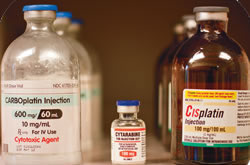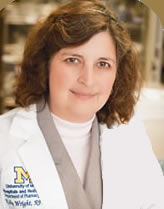Supply and Demand
U-M pharmacists, doctors collaborate to ensure patients get drugs they need, despite shortages

After Shawn Burr became a patient at the University of Michigan Rogel Cancer Center, his doctor asked an unusual question: Would he be able to bring his own chemotherapy drug?
The Rogel Cancer Center -- like many institutions throughout the country -- was facing a daunting shortage of cytarabine, a generic chemotherapy drug that is instrumental in treating acute myeloid leukemia, the form of cancer Burr has. Two of the three companies that make cytarabine had run into manufacturing problems: One couldn't obtain the raw materials necessary; the other had to recall batches because of quality concerns. The third company couldn't keep up with the resulting demand.

And so, when it became clear to Sherry DeLoach, a pharmacist who coordinates drug purchasing for Michigan Medicine, that stocks were running low, she notified the oncology pharmacists. They, in turn, met with the doctors whose patients use cytarabine to develop a strategy to ensure that every patient who needed the drug received it. One piece of this plan, among many others, was to ask newly referred patients if they could obtain the drug from their current health-care provider.
U-M would have provided Burr with the drug regardless of his answer. But Burr's care team at St. Joseph Mercy Port Huron Hospital was able to lend U-M enough cytarabine to accommodate his treatment.
"It's a pretty hopeless feeling," Burr said. "Usually, you think health care is all about money, but when it comes to generics, there's not a lot you can do if drug companies decide they aren't going to make a drug anymore. There needs to be some policy put in place to protect patients."
Drug shortages in all areas of medicine have become more common during the past several years, according to Erin Fox, chair-elect of the American Society of Health-System Pharmacists and manager of the University of Utah Drug Information Service. In 2001, 120 new shortages were reported; in 2010, there were 211. Twenty-three of the 2010 shortages -- 11% -- involved chemotherapy drugs.
Although the Rogel Cancer Center has experienced several drug shortages since 2008, no patients have had to go without drugs that were essential to their care, said Kelly Wright, a pharmacist and manager of the Rogel Cancer Center's ambulatory infusion areas.
Why Are Drug Shortages Occurring?
A number of problems cause shortages, said Allen Vaida, executive vice president for the Institute for Safe Medication Practices. Consolidation among pharmaceutical companies has had a major impact. If only three companies manufacture a drug, and two of them merge, often the third company can't keep up with the resulting demand. Even if a company has additional production lines available to produce a drug in demand, they cannot be used unless those specific production lines have federal approval to manufacture that specific drug.
In addition, Vaida said, the U.S. Food and Drug Administration recently stepped up inspections to ensure drug quality. Some manufacturers had to halt manufacturing temporarily to improve processes; others decided it wasn't worth the cost, so they stopped manufacturing certain drugs altogether. And since pharmaceutical companies have no obligation to notify anyone that they plan to stop manufacturing a drug, shortages often occur unexpectedly.
To help prevent this, Sen. Amy Kobuchar (D-Minn.) recently introduced a bill that would require companies to provide six months' notice to the U.S. secretary of health and human services of any manufacturing interruptions that would likely lead to a drug shortage.
"We are trying to advocate for more transparency because then at least practitioners could plan for shortages," Vaida said.
"We are doing all that we can to make sure our patients have the drugs they need," Wright said. "Every drug shortage has a different story; they're not all the same. But we are working closely with our clinicians -- who in many cases are leaders in their fields -- to develop ways to manage these shortages to ensure we are still providing the very best care possible."
Once doctors are notified of a potential shortage, said Jeffrey Smerage, M.D., Ph.D., medical director of the Rogel Cancer Center's infusion areas, the first thing doctors consider is who derives the greatest benefit from the drug. For some patients, the goal of treatment is to cure the cancer; for others, the goal of treatment is to control cancer for as long as possible. In most situations, more options and equivalent alternatives exist for patients undergoing treatment to control cancer than to cure it.
Next, doctors review what options are available for patients seeking a cure. Priority is given to those who have already started treatment with a given drug so that they can finish their regimen without interruption, Smerage said. Furthermore, doctors work with the pharmacy before starting any new patients on a particular drug to ensure that enough supply exists to allow a patient to complete a course of treatment.
Doctors also work with the pharmacy to ensure that no amount of drug is wasted, said Harry Erba, M.D., Ph.D., a Rogel Cancer Center oncologist who helped plan for the cytarabine shortage. If a vial is opened for one patient but the entire quantity is not needed, the team works together to figure out who else can use it so the excess does not go to waste.
In the case of the cytarabine shortage, Erba and his colleagues went a step further than typical conservation efforts. They reviewed the results of many studies to determine whether lower doses were equally effective. Lowering doses would allow more people access to the short supply of the drug. Given what they had found in recent medical publications, they found that they could cut doses in half in certain cases without any risk to patients.
"This was an opportunity to have a candid discussion about what is an adequate dose," Erba said. "We unanimously agreed that based on the most recent data, we could give patients the therapy they needed by limiting the doses by 50% of what we commonly give."
And as a result, no patients went without.
Read the Summer, 2011 issue of Thrive.
